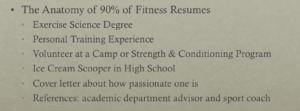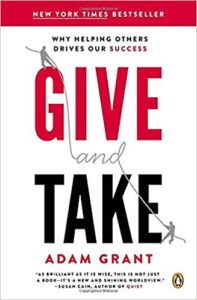
Random Thoughts on Long-Term Fitness Industry Success – Installment 8
I’m long overdue for a new installment on this series, so here are some thoughts that have been rattling around my brain on the business side of fitness.
1. Unique skill sets help you fill in the cracks.
I’m going to let you in on a little secret: most of the strength and conditioning resumes that come across my desk are painfully similar. Seriously, they are 90% the same. Here’s an excerpt from a presentation I gave earlier this year when I touched on the topic:
As you can probably infer, experience like this is really abundant – and what is abundant is rarely coveted. I’m not saying any of things are bad to have on a resume; I’m just saying that they’re prerequisites, not differentiating factors.
So how does an up-and-coming strength and conditioning professional stand out from the crowd? Here are a few examples:
a. Fluency in another language (Spanish is incredibly useful at CSP, where we train quite a few bilingual baseball players)
b.Technology proficiency beyond the “norms” (I can’t tell you how many times long-time CSP employee Chris Howard has helped out with everything from Powerpoint issues to wiring speakers)
c. A demonstrated history of lead generation and conversion (Have you built and grown a business? Have you found value where others missed it?)
d. An internship at an established facility (I’m going to look more fondly on someone who’s interned at IFAST, Mike Boyles, EXOS, or something comparable – as opposed to the person who chose a random YMCA on the other side of the country)
e. Playing AND coaching baseball (have you seen it from both sides of the lens?)
The possibilities are endless, but the point is that these unique skill sets are differentiating factors that make it easier for someone to justify hiring you.
2. Your bio is probably more important than you think.
Most of the time, when someone posts their bio on a website, it’s to make sure that prospective clients review it and recognize two things:
a. This person is qualified (Allison graduated from XYZ university with ABC degree, and has achieved these certifications)
b. This person is relatable (In his spare time, Doug enjoys walking his two pet schnauzers and eating ice cream with his wife of 27 years, Peggy.)
An experience the other night reminded me that it’s important to give equal attention to each.
This guy lost out on a pretty big time client because he focused too much on being relatable; almost his entire bio was targeted toward potential patients, but not other practitioners who might be looking to evaluate his clinical skill set for the purpose of referrals.
When you write your bio, make sure you include components of both – and that might mean you have to trim the fat on some of the non-essentials.
3. Slow and steady still wins the race.
Have you ever heard the story of the small company who gets a big breakthrough to get their product on the shelves of Wal-Mart or Target – and then goes out of business just months later because they didn’t have the short-term cash flow to keep up with a huge surge in production demands and inventory needs? Their systems couldn’t keep up with their lead generation.
Many trainers would kill to add 20 new clients, but most fail to realize that they don’t have the systems in place to take on that many new people and still deliver a high quality product. This is a classic story when a fitness bootcamp runs a Groupon to bring in a surge of new prospects – only to see their long-term members get irritated at crowded classes, watered down programming, and “flightly” training partners who go from one gym to the next each month. The systems weren’t ready for the surge in leads.
Last summer, my business partner, Brian Kaplan, co-founded The Collegiate League of the Palm Beaches near our Jupiter, FL Cressey Sports Performance location.
In a matter of weeks, we added over 60 new college baseball players as 3-5 days/week clients for a two-month period. It took months of planning to make sure that we were staffed accordingly, and included loads of email outreach to schedule evaluations. It even meant that there were a few cases when we had to turn away “drop-in” evaluations from college guys who hadn’t scheduled in advance. I even flew down from Massachusetts for a week to help out with the initial surge.
As Aaron Ross and Jason Lemkin wrote in From Impossible to Inevitable, “Speeding up growth creates more problems than it solves.” It only makes sense that this would be a huge issue in the fitness industry, where we have people who are often skilled technicians, but not very savvy entrepreneurs and managers. So, unless you have your systems fine-tuned, be careful what you wish for when it comes to expanding your offering to new markets or within the existing market.
4. Read this post from my business partner, Pete Dupuis.
This is an excellent lesson that can apply to any endeavor in business and in life.
The Value in Giving More Than You Take
If you’re looking for a longer read on this front, I’d highly recommend Adam Grant’s Give and Take.





